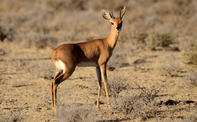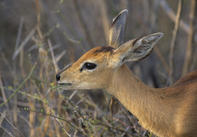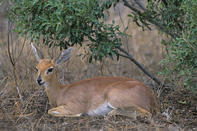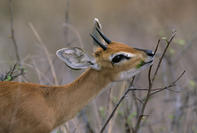Male Horns Only
The steenbok is brick-red in colour with noticeable white underparts. Its colloquial name is derived from the Afrikaans word ‘steen’, which means brick because of its red-brown colouration.

A male steenbok possesses two pencil-like parallel horns, which females lack. The white underparts of the steenbok are noticeable when these small antelope run away. Their bounding gait is such that the rump bounces up exposing the white colour.
This is possibly a form of flash coloration and offers a target to its pursuer. As soon as the antelope stops the white is no longer visible and the antelope blends in with its grassy habitat and becomes lost to the predator. Steenbok rely on hiding in long grass to escape notice as well. Where cover is limited they have been known to hide in holes such as those made by aardvark in the sides of termitaria.
Territory Markings

Steenbok are solitary antelope except for females accompanied by a lamb or a courting male.
The male and female reside in abutting if not overlapping territories of about 0.03 km² in extent, which they defend from other members of their species with passive demonstrations, combat seldom occurs, and scent markings from the preorbital glands, in front of the eyes, pedal glands, between the hooves, and throat glands.
Steenbok urinate and defecate in latrines, which they then take great care to cover up. Although buried, they still seem to play a role in territory demarcation as they are usually located on the perimeter of the territory.
Water Independent

Steenbok are capable diggers and will unearth bulbs and rhizomes to eat. They also utilize the scraps left behind after porcupines have excavated holes to reach roots.
Because of the moisture content of this sort of food, steenbok do not need to drink and are water-independent. They further conserve moisture and energy by lying up in the shade during the hottest part of the day.
Quick Facts

0.52 m shoulder
Weight
11 kg (female larger)
Lifespan
10 years
Habitat
Open country with scattered cover
Gestation
7 months
Number of young
1
Food
Mixed feeders – eat mostly forbs also grass, fruit, flowers, seeds, dig for bulbs
Predators
Medium to large carnivore, Martial eagle
By Megan Emmett